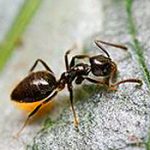This species is a scavenger/predator ant that will eat most household foods, especially those that contain sugar, and other insects. Indoors they will colonize near heat sources or in insulation. In hot and dry situations, nests have been found in house plants and even in the lids of toilets. Outdoors they tend to colonize under rocks and exposed soil. They appear, however, to form colonies virtually anywhere, in a variety of conditions. They can trail extensive distances (though their trails are rarely longer than 50 feet), usually along landscape edges. Colonies range in size from 100-10,000, and house several queens (as many as 200, in some instances). They are non-aggressive. While queens can lay as many as 20-30 eggs in single day, they lay only 1-2 (or less) eggs per day on average over long periods of time. Typical time to adult phase of development is 34-38 days. It is believed that queens and male ants are only produced in larger colonies.
They appear to be more likely to invade homes after rain (which washes away the honeydew they collect).
Odorous house ants appear to be highly tolerant of other ants, with compound nests consisting of multiple ant species (including T. sessile) having been observed. They range in colour from brown to black and range in length from 1/16 to 1/8 inches. Their antennae have 12 segments. Little is known about the lifespan of the ant, though it has been shown that queens can live at least 8 months (and probably much longer), workers at least a few months (and show every indication of living as long as queens), and males appear to live only approximately a week.
The odorous house ant is very tough, and injured workers have been observed to continue living and working with little hindrance. Some queens with crushed abdomens could still lay eggs, and there are documented instances of T. sessile queens surviving without food or water for over two months. They also appear highly tolerant to hot and cold temperatures. These ants are tough to remove from the body and leave an odorous smell as well.
These ants are not hard to control, and most ant killers will solve problems, especially if controlled as soon as the problem is noticed. At this point, they could be put under control in just a few days. However, the longer someone waits, the larger the population is and the longer it will take to control the situation, possibly a few weeks. Standing water should be eliminated, as odorous house ants are attracted to moisture. Plants should be trimmed back so they cannot be used to get inside. Cracks, holes and joints should be sealed with polyurethane foam or caulk, especially those that are near the ground. Firewood, rocks and other materials should not be stored next to a home because it encourages nest building. People should be on the lookout for these ants in late winter and early spring (particularly after rain), as this is when they most commonly appear.

